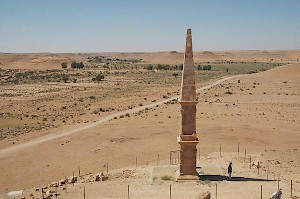Msletten
Q71990815Msletten ("needles"): name of a pair of obelisk-shaped tombs along the Wadi Nefud in Libya.

Several places in Tripolitana are called Msletten, which means "needles". The place to which this page is dedicated is not the famous one east of Bani Walid, but another one, situated along the desert road from Banu Walid to Qasr Banat and Ghirza. It is in the Wadi Nefud, in an area where dromedaries roam almost in the wild. The needles are two mausoleums from the third or fourth century, in typical Tripolitanian style. Similar needles can be seen in the Wadi El-Amud (along the road from Gheriat esh-Shergia to Mizda) and at the South Cemetery of Ghirza. Another well-known "needle" is at Sabratha.
The northern tomb is locally known as Umm el-Omad ("mother of all needles") and is called Nf30 (=Wadi Nefud, monument #30) in the catalogue by Graeme Barker e.a., Farming the Desert. The UNESCO Libyan Valleys Archaeological Survey (1996).
 Msletten, Northern tomb, Dromedaries blocking our approach |
 Msletten, Northern tomb, lower section |
 Msletten, Northern tomb, middle section |
 Msletten, Northern tomb, upper section |
The tombs offers a couple of suprises. The Corinthian columns are completely Roman, but the shape of the monuments is Punic. The epitaph, for example, is flanked by two eagles, which is customary in this area. The false doors have their closest parallel in the art of ancient Egypt. Oddly, the false door in the northern monument faces the southeast, and not - as one would have expected - the west, the realm of the dead. Perhaps the person who lies buried here, a man named Ben Hamdan, wanted to connect his tomb to the Unconquered Sun (Sol Invictus), which in December rises in the southeast.
The second mausoleum stands an a hill across the wadi, directly south of the northern one. The southern needle is known as and Shapet el-Amud ("needle of the brook") or Nf31 (=Wadi Nefud, monument #31). There are five more tombs in the area and it is likely that the dead once were the inhabitants of the nearby farm.
 Msletten, Northern tomb, Corinthian capital |
 Msletten, Farm |
 Msletten, Southern tomb |